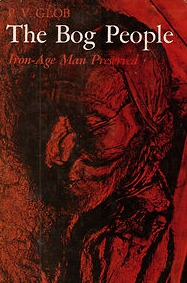Inspiring Older Readers
 posted on 12 Oct 2023
posted on 12 Oct 2023
Rereading The Bog People by P. V. Glob
P. V. Glob’s book, The Bog People, was first published in English translation by Faber in 1969 and subsequently in paperback by Paladin in 1971. It is about the finding of almost miraculously preserved Iron Age bodies in bogs and fenland in Denmark and other parts of Northern Europe throughout the 1940s, 50s and 60s, with a particular focus on the two that became known respectively as Tollund man and Grauballe man.
This potentially rather arcane book by a Danish archaeologist became something of a popular phenomenon thanks in part to the extraordinary photographs it included and Glob’s perfectly pitched writing for the layperson. It is a book that has intrigued me for decades; or rather, a book whose influence on other writers – notably the poet Seamus Heaney – has intrigued me for decades.
In his foreword Glob quotes from a letter he received in 1962 from a class of young girls at a convent boarding school in Suffolk; they hope they are not bothering him and ask what more he can tell them about the Tollund man. The Bog People is really Glob’s ‘long letter’ in reply. It is evident that explaining the bog people’s story for a new and younger audience was a responsibility Glob took extremely seriously and the book testifies to this: it is crisply and lucidly written and has a certain elegance and even charm, thanks in no small part to the excellent translation.
Of course, what has gripped the imaginations of many of its readers is the assertion that the majority of the bog people so far found met violent deaths, with some displaying signs of ritual sacrifice and others – especially women – appearing to have been killed during brutal, public punishment for offences considered to bring disgrace to the tribe, such as adultery. While advances in forensic techniques are now calling some of Glob’s theories into question, there can be no doubt regarding the importance of his pioneering work in identifying the role played by either sacrifice or execution in these Iron Age deaths.
As well as being a fascinating story, Glob’s account of the bog people has also proven a rich source of often darkly inspiring imagery for other writers, most notably perhaps Seamus Heaney, who over the years wrote a number of ‘bog poems’ drawing parallels between these ancient killings and the sectarian ‘disappearances’ and punishments that Ireland experienced during the worst of the Troubles.
Despite their distance in time, Heaney found that these Iron Age discoveries felt terribly, awfully close: ‘The Tollund Man,’ he said in a 1979 interview, ‘seemed to me like an ancestor almost, one of my old uncles, one of those moustached archaic faces you used to meet all over the Irish countryside. I felt very close to this. And the sacrificial element, the territorial religious element, the whole mythological field surrounding these images was very potent. So I tried, not explicitly, to make a connection between the sacrificial, ritual, religious element in the violence of contemporary Ireland and this terrible sacrificial religious thing in The Bog People.’
In his marvellous poem ‘Punishment’, for example, he considers an Iron Age woman thought to have been murdered for committing adultery and the dreadful complicity of silence that he had himself felt when witnessing the tarring and feathering of women ‘collaborators’ by sectarian mobs in Ireland: we ‘would connive/in civilised outrage’ he says, ‘yet understood the exact/and tribal, intimate revenge’.
The discoveries of the Danish bog people from two thousand years ago now seem doubly remote. When Tollund man was discovered in 1950 the conditions surrounding his excavation were extraordinarily primitive. For instance, it was impossible for any machines to be brought to the site and the body had to be exhumed and packed in around a ton of peat to ensure its safe transit by horse cart to the nearest station and a week-long journey across Denmark to Copenhagen. During this strenuous excavation one of the helpers suffered a heart attack and died.
Even if, like me, you have only a limited appetite for Iron Age history I still think you will find this an unusual and profoundly evocative book that speaks powerfully across two millennia. When I finished it I couldn’t help thinking that another writer who surely would have loved the book had he lived long enough to read it is M. R. James. Just imagine: an early winter’s dark in a Danish fenland, flares and oil-lamps are spluttering in the wind and a group of exhausted men are straining to raise a rough, peat-filled wooden box onto the bed of a waiting horse-cart; as the box rises thick brown water streams from it; the waiting horses are stamping in the cold, their breath showing briefly white before the wind snatches it away… He wouldn’t have been able to resist it.
Alun Severn
October 2023